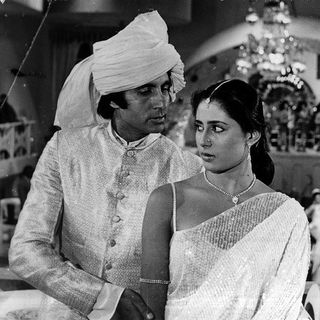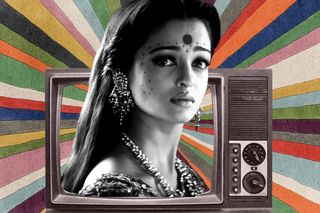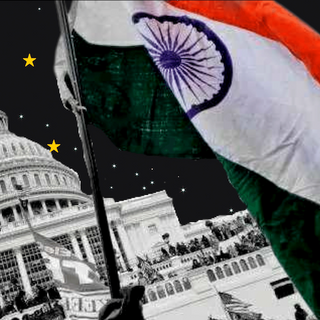
Can We Move On: From The Long‑Suffering Woman Trope As A Vehicle To Highlight Men’s Virtues
She is beautiful, altruistic, tragic, and never ever in control of her own narrative.

In Can We Move On, we revisit old tropes and question whether they have any remaining cultural relevance.
The Long-Suffering Woman is perhaps Bollywood’s most recognizable character, yet the most invisible. Officially, she’s the designated love interest for all action heroes, and some tragic heroes. In reality, her purpose is to be a lovely, yet macabre, reflective surface that magnifies the hero’s own brilliance.
Usually, the love interest’s purpose in a main character’s storyline is to offer pleasant, almost bland support. The Long Suffering Woman takes it a step further — she sustains loss, death, disfigurement, violence, rape and so much more, for the sole purpose of triggering the hero’s viruous rage towards either violence, or his own tragic end. This singular purpose has remained steady for decades, simply because the audience enjoys women in danger and avenging women in danger.
The defining traits of the Long Suffering Woman are her beauty, her saintly altruism, and her fragility — these traits also pop up in her plot line in that order. In Vivah (2006), Poonam Mishra (Amrita Rao) is a beautiful girl ill-treated by her family because she’s — get this — fair-skinned. After her marriage is fixed, she’s trapped and later disfigured in a fire while trying to save a family member’s life. Her trauma is then used to showcase how the hero accepts her regardless of her disfigurement. Ghajini (2008) showcases another iteration of this trope, where Kalpana (Asin) dies a brutal death after saving young girls from sex-traffickers. Her death causes the lead character’s (Aamir Khan) abrupt turn towards revenge-and-vigilante justice fuelled violence. And if the film lets the Long-Suffering Woman keep her physical body intact, it makes sure to inflict severe mental devastation instead. Case in point: Devdas (2002), where beautiful Paro (Aishwarya Rai) suffers humiliation for her caste by Devdas’s (Shah Rukh Khan) family and is sent away to spent her eternity in a loveless marriage, but must also watch the love of her life die a bitter, lonely death via alcoholism as a direct reaction to losing her.
Though out of place amid a new stream of ’empowerment’ focused films with women leads, the Long Suffering Woman’s frequent presence in mainstream films highlights something darker — women are not in charge of their own narratives. The audience isn’t ready to engage with what women have to say about their own distress, because revenge and virtue fantasies built from women’s pain is a norm for Bollywood entertainment.
Related on The Swaddle:
Bollywood Needs Heroes Who Don’t Self‑Destruct When They’re in Love
“The reclaiming and validation of women’s experience has been central to feminism since the beginning of the second wave…[F]eminists have argued that men define reality on their own terms, to legitimate their experience, their own particular version of events,” write researchers Celia Kitzinger and Sue Wilkinson in Validating Women’s Experience? Dilemmas in Feminist Research. They add, “Women’s experience, not fitting the male model, is trivialized, denied or distorted; our perceptions are systematically pathologized; we are crazy women, imagining things, making a fuss about nothing. Feminism has involved, crucially, a reclaiming and naming of women’s experience, and a challenge to the male monopoly on truth.”
Women’s trauma — both in cinema and in the real world — is almost never depicted accurately. Medicine has long dismissed or ignored women’s pain and further health issues for a variety of reasons, while also using arbirtrary mental illness diagnoses to silence them. Women who suffer sexual violence are seen as responsible for their own plight from all pillars of democracy — from the law, to the media and the common citizen. Highly acclaimed TV shows made in India continue to use sexual violence against women to provoke a visceral reaction from the audience, but refuse to delve too deeply into the aftermath, unless again, it is to set up the male protagonist’s narrative.
Related on The Swaddle:
Portrayals of Female Revenge in Pop Culture Simply Mirror Toxic Male Violence
It’s easy to understand why films written by men and for men choose to glorify plot lines like rape revenge fantasies (Kaabil) and extra-judicial killings (Simbaa) — men want to see their heroes take power into their own hands and right the wrongs in the world. That, according to the male narrative, is the only vital importance of showcasing women’s trauma.
But, women disagree. As Kitzinger and Wilkinson state, feminists have chipped away at male control over women’s narratives for years — steadily gaining ground with time. Women with the chance to speak about their trauma can achieve mental peace, gain community and even start revolutions. Whether it’s groups of women who help each other cope with chronic, underresearched ailments, or women who band together to speak up against powerful, abusive men or even women who write films about women — a woman’s perspective on her own trauma is a far more accurate perspective than a strange man’s — making it closer to truth and fairness for the woman in question.
The Long Suffering Woman is a cog in the male virtue fantasy wet dream, which unfortunately churns out blockbuster after blockbuster. But the fruits of decades of feminist labor ensure that each average woman who watches such films has a small, persistent voice in her mind asking, “Who could she be if she told her own story?”
Aditi Murti is a culture writer at The Swaddle. Previously, she worked as a freelance journalist focused on gender and cities. Find her on social media @aditimurti.
Related


The Buzz Cut: Indian Patriotism Finds Its Way to the Pro‑Trump Rally
